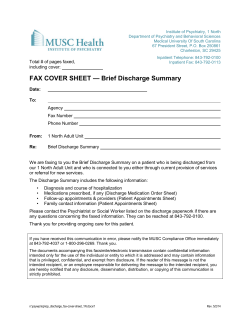
CE 3620: WATER RESOURCES ENGINEERING EXAM I SAMPLE PROBLEMS
CE 3620: WATER RESOURCES ENGINEERING EXAM I SAMPLE PROBLEMS NOTE: These questions were for a 50 minute exam. The exam was closed book. Students were allowed one 8.5” x 11” crib sheet (two-sided) with handwritten material. Problem 1 Given: Circular concrete pipe culvert 500-ft long, with a slope of 0.006, maximum headwater depth of 15.7 ft, a mitered entrance, and a free-jet outlet. The design discharge coming from the upstream catchment is 330 cfs. Assume f = 0.02, Ken = 0.6, Co = 0.62. Find: Culvert diameter. Answer: Doutlet control = 4.97 ft, Dinlet control = 4.82 ft; choose larger value to ensure limiting discharge meets design discharge. For D = 4.97 ft, the corresponding velocity is sufficient for selfcleansing (V > 2 ft/s). But to avoid damage to the structure with velocity being overly high (V > 10 ft/s), we would need to size up to D = 6.48 ft. Problem 2 Given: A pump is installed to deliver water from one reservoir to another as shown below. The 12-in diameter suction pipe (f = 0.020) is 50 ft long, and the 10-in diameter discharge pipe (f = 0.032) is 4000 ft long and includes a fully open gate value (KM = 0.2). Minor loss coefficients for the entrance and exit from the pipeline are indicated in the figure below. The pump characteristic curve may be defined as Ep = 300 – 20Q2, where Ep is the pump head in ft, and Q is the discharge in cfs. 1 Find: (a) Compute the discharge rate, Q (cfs), for this system. (b) Compute the pressure at the pump intake. (c) Consider the pump characteristics curve below. Is the pump optimal? Explain why or why not. If it is not optimal, then sketch the ideal system curve when the single pump is in use. Is it feasible to alter the system to attain the ideal system curve? Could you alter the pump curve to increase efficiency? 450 1 400 0.9 350 0.8 Head (ft) 0.6 250 0.5 200 0.4 150 0.3 100 0.2 50 0.1 0 0 0 0.5 1 1.5 2 Discharge (cfs) 2.5 3 3.5 Answer: (a) Q = 1.886 cfs (b) Pintake = 64.94 psi (c) Not optimal. The pump is only operating at 58% efficiency when Q = 1.886 cfs. 2 Efficiency 0.7 300 EQUATIONS AND CONVERSION FACTORS ∑ Fx = βρQ(V2 − V1 ) Q = NpA 2 gH L K en + K f + 1 P1 P αV 2 αV22 + z1 + 1 + E p =2 + z2 + + HL + HM γ 2g γ 2g = Q N p AeCo 2 g ( H − D / 2) Q = VA HL = f L V2 D 2g HM = K V2 2g HL = Pwater = γQEp Pshaft = Pwater/η 1 mile = 5280 ft 1 inch = 2.54 cm 1 acre = 43,560 ft2 1 mi2 = 640 acres g = 32.2 ft/s2 = 9.81 m/s2 γ = 62.4 lb/ft3 = 9.79 kN/m3 3 n 2V 2 L Cm2 R 4/3 1 ft3 = 7.48 gallons
© Copyright 2025





















